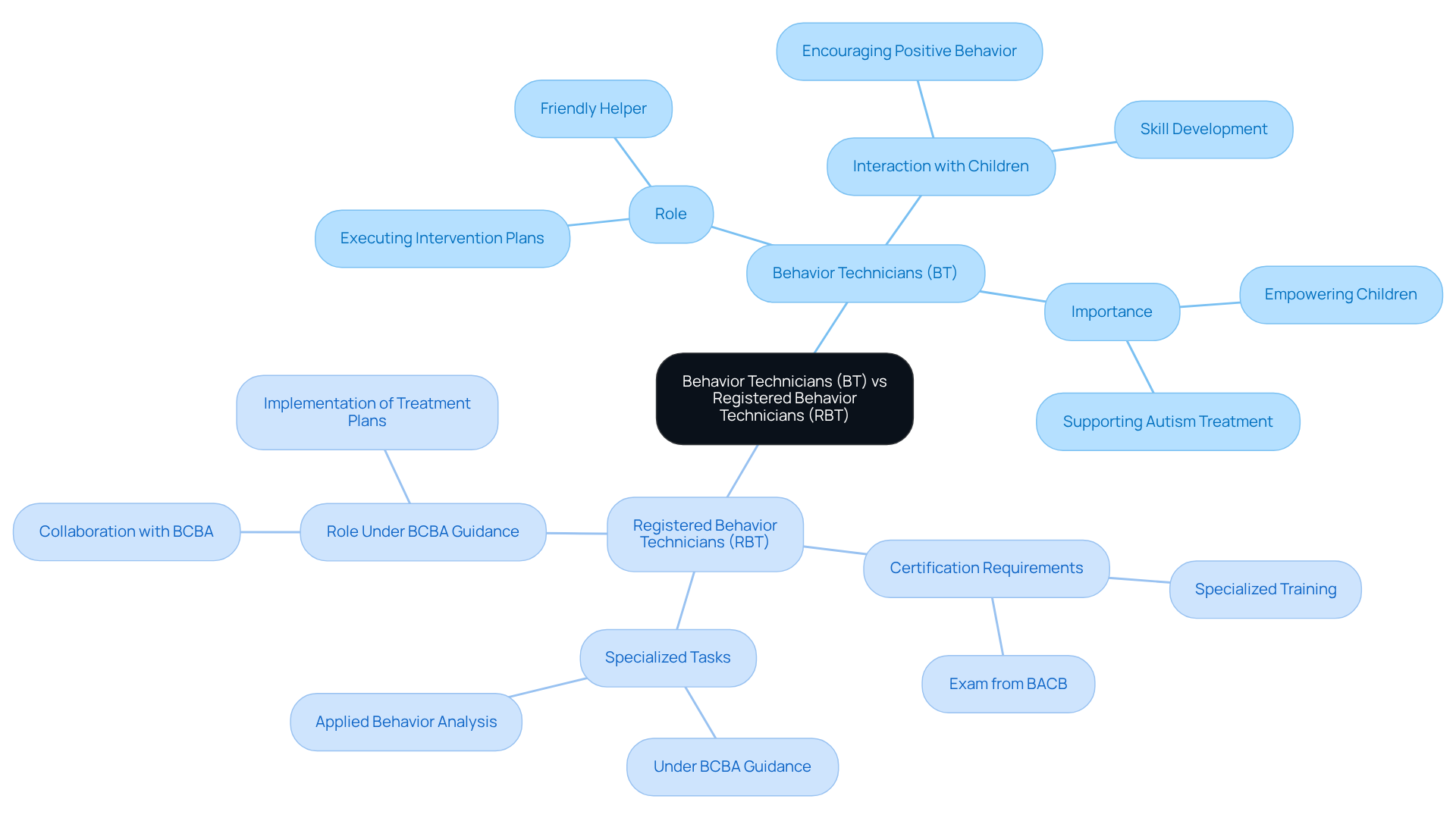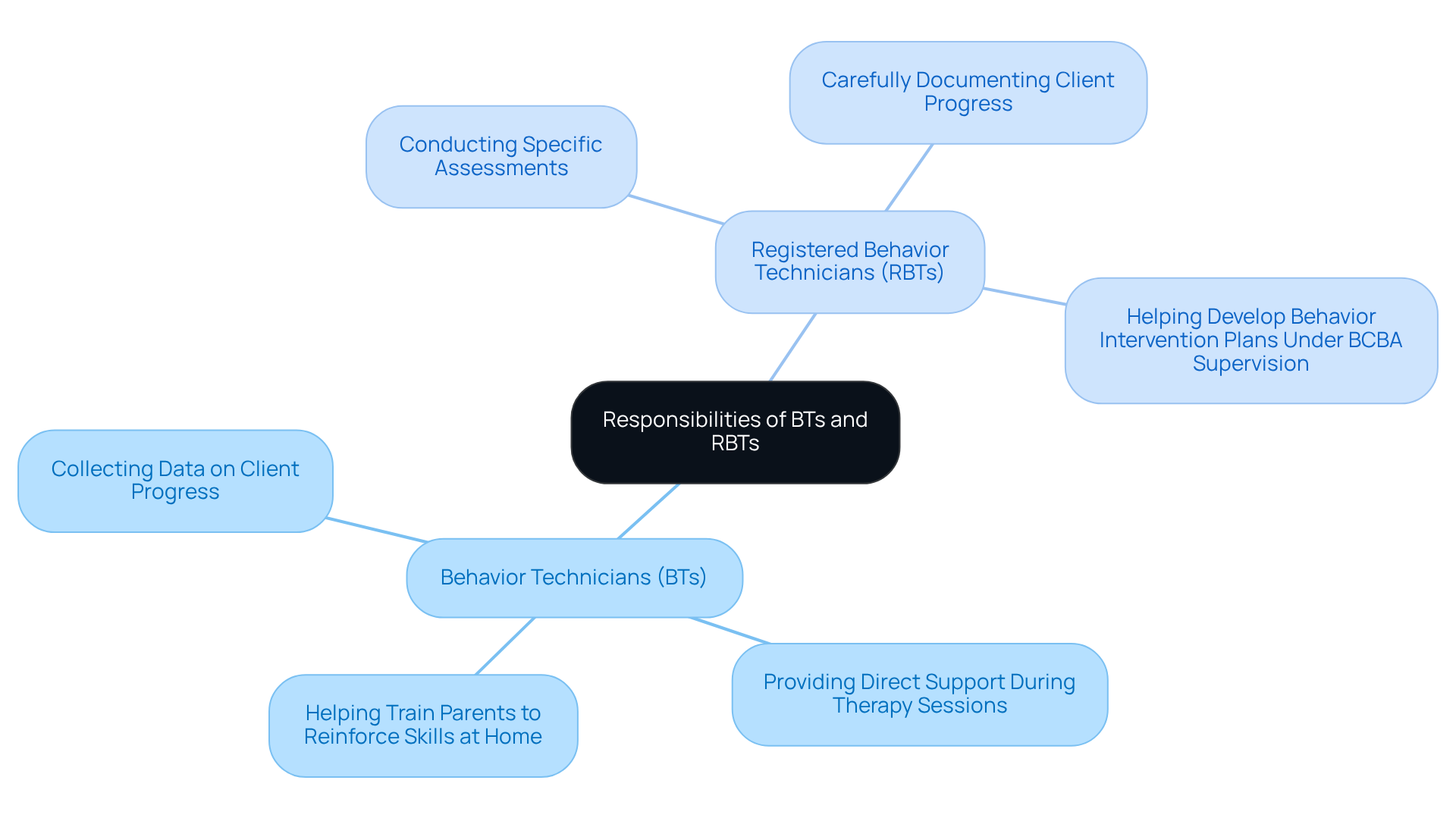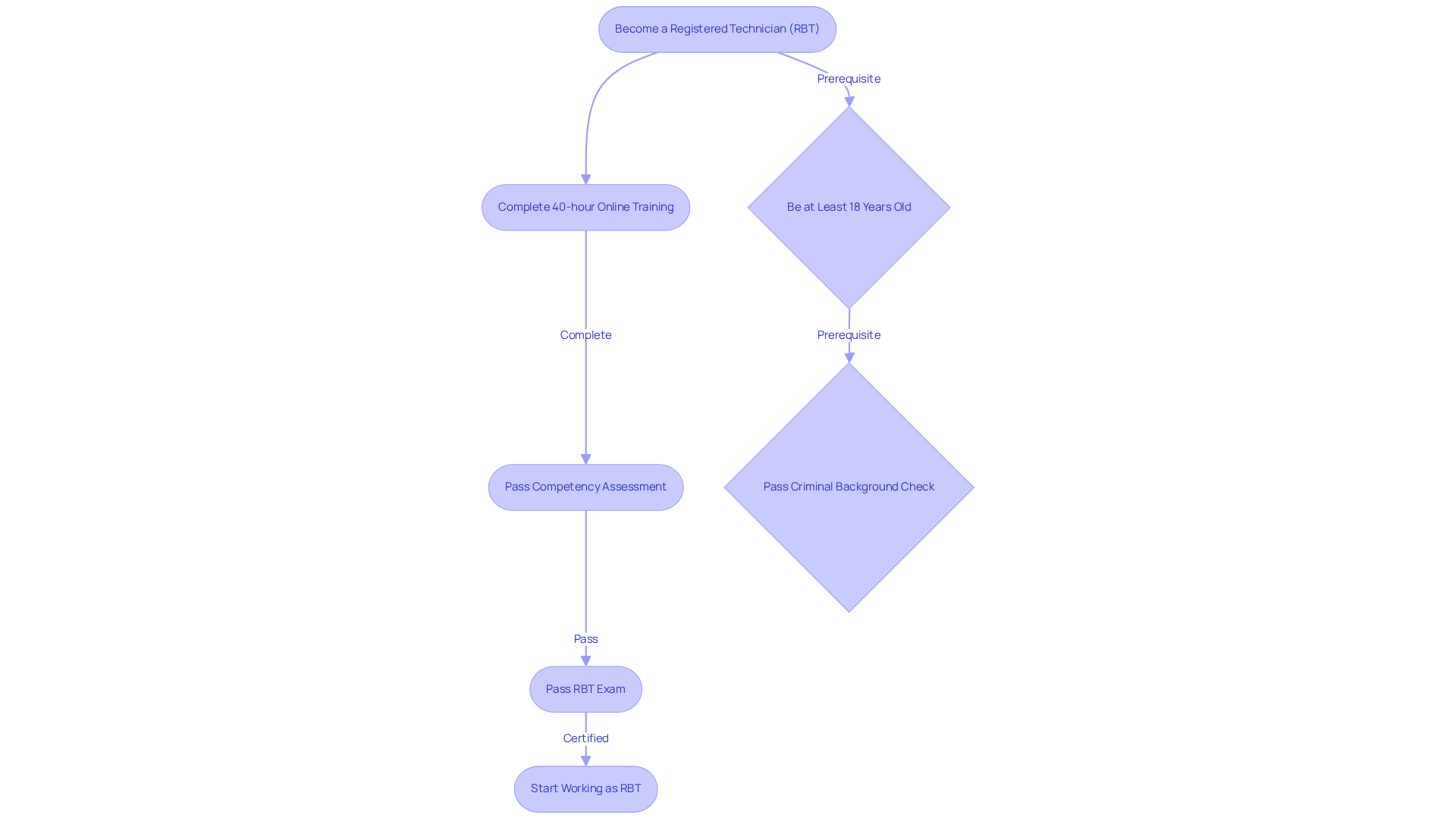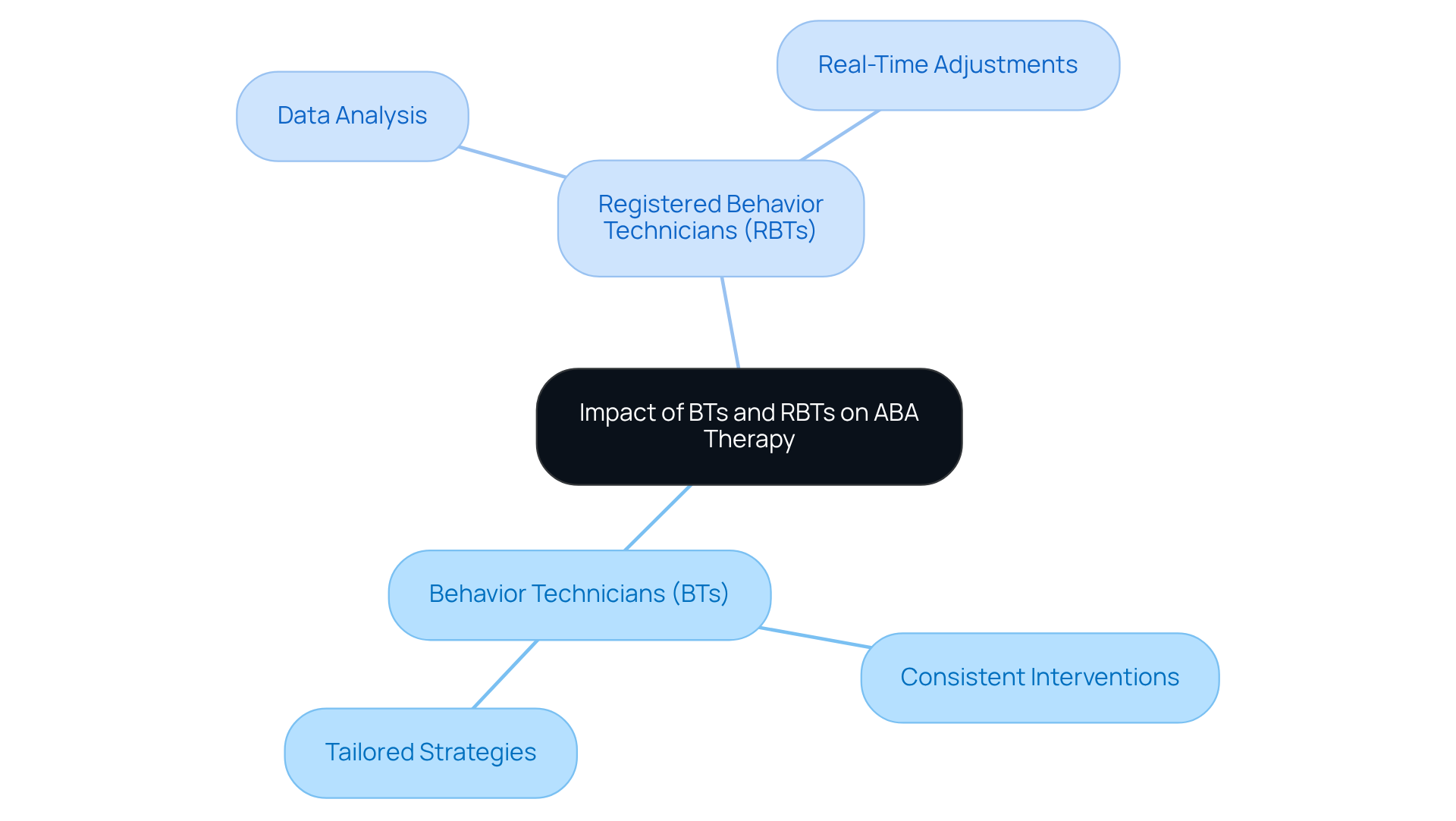The article highlights a key difference between Behavior Technicians (BTs) and Registered Behavior Technicians (RBTs): it’s all about certification and training! BTs are like supportive helpers, working under the guidance of a Board Certified Analyst (BCBA). On the other hand, RBTs are certified professionals who have completed specialized training, allowing them to tackle more complex tasks in Applied Behavior Analysis (ABA).
This distinction is really important! The article emphasizes how RBTs have enhanced responsibilities, which can lead to better treatment outcomes for children with autism. It showcases how both roles are vital in ABA therapy, contributing to a supportive environment for families. Let’s explore this together and see how these roles can make a difference in your child's journey!
Understanding the roles of Behavior Technicians (BTs) and Registered Behavior Technicians (RBTs) is super important in the world of Applied Behavior Analysis (ABA) therapy, especially as the need for effective autism interventions keeps growing. Both positions play significant roles in supporting children with autism, but their responsibilities and qualifications differ quite a bit. This means they each contribute uniquely to treatment outcomes.
So, how can families navigate these differences to ensure their child gets the best support possible? Let’s explore the vital distinctions between BTs and RBTs, shedding light on their impacts within ABA therapy and what it means for those seeking the best care for their loved ones.
A Technician (BT) is a friendly helper who plays a crucial role in executing personalized intervention plans, illustrating the difference between BT and RBT, all under the watchful eye of a Board Certified Analyst (BCBA). They work directly with children, especially those with autism, using techniques that encourage positive behavior and essential skill development. This empowers kids to explore the world around them with confidence!
On the other hand, the difference between BT and RBT is that a Registered Behavior Technician (RBT) is a certified professional who has completed specialized training and passed an exam from the Behavior Analyst Certification Board (BACB). RBTs work under the guidance of a BCBA, and their certification allows them to take on more specialized tasks within Applied Behavior Analysis, illustrating the difference between BT and RBT.
As of 2025, there are about 60,000 certified behavior technicians in the United States! This number reflects the growing recognition of their vital role in improving autism treatment outcomes. The presence of RBTs in treatment settings has shown to significantly enhance the effectiveness of interventions, leading to better progress for individuals with autism.
At Rori Care, we’re all about making ABA support more efficient! Our behavior care engine conducts functional behavior analysis and generates automatic progress reports for clinician review. This innovation frees up 50% more time for child treatment, ensuring that families receive the comprehensive and compassionate support they need throughout their child's development. Let’s explore this together!

Technicians, often referred to as BTs, play a vital role in carrying out treatment plans crafted by Board Certified Analysts, or BCBAs. Their responsibilities include:
Now, let’s talk about Registered Behavior Technicians, or RBTs. They share similar responsibilities but have heightened expectations due to their certification. RBTs are specially trained to:
This distinction highlights the RBT's role as a more specialized and responsible member of the ABA treatment team, which is crucial for ensuring effective treatment outcomes.
Did you know that studies suggest youngsters receiving at least 20 hours of ABA intervention weekly show more significant progress than those receiving under 10 hours? This really emphasizes the importance of consistent and skilled execution of treatment by both BTs and practitioners. Moreover, research indicates that 90% of young individuals experience significant advancements when the recommended hours are fully applied. It’s clear that treatment hours matter! The partnership between RBTs and BCBAs ensures that therapy stays aligned with each child’s unique needs, enhancing the overall effectiveness of the intervention.
And here’s something exciting: the use of AI-driven progress report automation allows for automatic data gathering during clinical sessions, freeing up 50% more time for treatment! This efficiency not only boosts the overall effectiveness of the intervention but also empowers caregivers with ABA principles and strategies to support their children's behavioral goals through active involvement. As families seek effective autism treatment, understanding the difference between BT and RBT becomes increasingly vital. Let’s explore this together and see how these roles can make a difference in your child’s journey!

To become a Technician (BT), it is important to know the difference between BT and RBT, and typically a high school diploma or equivalent is required. Some employers might even prefer candidates with a bit of college education in a related field. While there are no formal certification requirements for BTs, training in ABA principles can be super helpful!
Now, if you're looking to become a Registered Technician (RBT), understanding the difference between BT and RBT is crucial as there’s a clear path to follow. First, you need to complete a comprehensive 40-hour online training program that dives into practical lessons based on the RBT Task List. After that, you’ll take a competency assessment and pass the RBT exam administered by the Behavior Analyst Certification Board (BACB). Plus, keep in mind that you must be at least 18 years old and pass a criminal background check.
This organized route ensures that Registered Behavior Technicians are well-equipped to deliver effective ABA treatment. They empower caregivers with essential ABA concepts and methods, making it easier to optimize behavioral assistance and intervention. Let’s explore this together and see how you can take the next step in this rewarding journey!

The difference between BT and RBT is crucial, as both Behavior Technicians (BTs) and Registered Behavior Technicians (RBTs) play a vital role in making Applied Behavior Analysis (ABA) effective, significantly impacting treatment success. BTs ensure that interventions are applied consistently and accurately, which is key to achieving those desired behavioral outcomes. Their hands-on support allows for practical strategies that are tailored to each individual’s unique needs.
Now, let’s talk about Registered Behavior Technicians. With their specialized training and certification, they enhance the treatment process by gathering and analyzing data that informs essential treatment changes. This data-driven approach not only elevates the quality of care but also allows for real-time adjustments to better meet the evolving needs of clients. For instance, research indicates that children receiving regular ABA interventions with RBTs show remarkable improvements in communication skills and adaptive behaviors, achieving a success rate of over 89% in addressing autism spectrum disorder (ASD).
Understanding the difference between BT and RBT is truly essential in the collaboration between BTs and RBTs to foster independence and enhance social skills in children with autism. Their combined efforts lead to improved treatment outcomes, as data shows that kids involved in sessions with both BTs and RBTs tend to make greater overall progress, illustrating the difference between BT and RBT compared to those who receive support from just one type of technician. This teamwork not only benefits individual clients but also aligns beautifully with the broader goals of ABA therapy, which aims to empower families and promote lasting behavioral change.
So, if you’re navigating this journey, know that you’re not alone! Let’s explore this together and see how these dedicated professionals can make a difference in your child’s life. We’re here to help you every step of the way!

Understanding the difference between Behavior Technicians (BTs) and Registered Behavior Technicians (RBTs) is so important for anyone navigating the world of Applied Behavior Analysis (ABA) therapy. Both roles play a crucial part in delivering effective interventions, but the RBT's certification and specialized training really elevate their responsibilities. This allows them to contribute even more significantly to the treatment process. Recognizing these distinctions not only clarifies their functions but also highlights how they work together to create positive outcomes for children with autism.
In this article, we've explored key points, such as the differences in responsibilities, educational requirements, and the impact both BTs and RBTs have on therapy effectiveness.
We also highlighted the importance of consistent ABA therapy, noting that children who receive enough hours of intervention show remarkable progress. Plus, the use of technology in tracking progress makes therapy delivery even more efficient!
As families search for effective autism treatment, understanding the critical roles of BTs and RBTs becomes essential. Their combined efforts not only enhance individual client outcomes but also contribute to the bigger picture of empowering families and promoting lasting behavioral change. By encouraging collaboration between these dedicated professionals, the path to success in ABA therapy becomes clearer, ensuring that every child receives the support they need to thrive. Let’s explore this journey together, and remember—we’re here to help you every step of the way!
What is a Behavior Technician (BT)?
A Behavior Technician (BT) is a friendly helper who plays a crucial role in executing personalized intervention plans for children, particularly those with autism. They use techniques that encourage positive behavior and essential skill development under the supervision of a Board Certified Analyst (BCBA).
What distinguishes a Registered Behavior Technician (RBT) from a Behavior Technician (BT)?
The main distinction is that a Registered Behavior Technician (RBT) is a certified professional who has completed specialized training and passed an exam from the Behavior Analyst Certification Board (BACB). RBTs can take on more specialized tasks within Applied Behavior Analysis while working under the guidance of a BCBA.
How many certified behavior technicians are there in the United States as of 2025?
As of 2025, there are approximately 60,000 certified behavior technicians in the United States, highlighting the growing recognition of their important role in improving autism treatment outcomes.
What impact do RBTs have in treatment settings?
The presence of RBTs in treatment settings has been shown to significantly enhance the effectiveness of interventions, leading to better progress for individuals with autism.
What innovative approach does Rori Care use to support ABA?
Rori Care utilizes a behavior care engine that conducts functional behavior analysis and generates automatic progress reports for clinician review, freeing up 50% more time for child treatment and ensuring families receive comprehensive and compassionate support throughout their child's development.